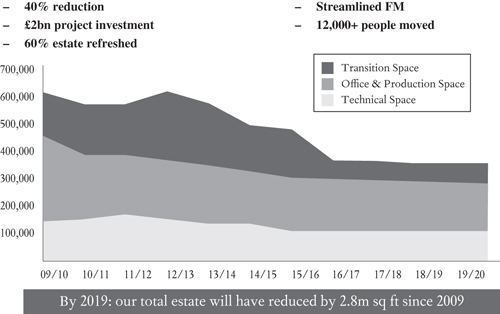
All that is best in every department of human knowledge, endeavour and achievement.
John Reith, First Director-General of the BBC
The BBC Story is my personal view of one of the UK’s world-famous institutions, undergoing a once-in-a-lifetime, large-scale transformative property/business initiative. As Head of BBC Corporate Real Estate between 2004 and 2012 and then CEO of the BBC’s Commercial Projects until 2015, I felt enormously privileged to be part of this extraordinary organization at a critical juncture in its long history. More importantly, it gave me the opportunity to work with so many inspiring, talented and creative people who supported me in the challenge to transform the Corporation’s estate and make it fit for the demands of the twenty-first century. This is their story just as much as mine and it has never been told before through the lens of the BBC’s regeneration programme, where the organization was, literally and figuratively, switched from analogue to digital.
My part in all this was developing, financing and implementing the BBC’s £2-billion property strategy and realizing the organization’s goal to consolidate and upgrade its fragmented estate after decades of under-investment. Additionally, my remit was to create better working environments for employees, both in London and other regional hubs all over the UK. Although one aspect of the project was the renovation of the BBC’s historic central London HQ Broadcasting House, another aim for the regenerated BBC was to shift its mainly London-centric broadcasting production to other regions. This involved a new HQ for BBC Scotland, studios in Cardiff and many smaller schemes in Liverpool, Coventry, Leeds, Hull, Cambridge, Southampton and Birmingham. The centrepiece of this regional development was the creation of a brand-new centre of broadcasting excellence, MediaCityUK in Salford, near Manchester.
The final piece of the jigsaw was the rationalization of the BBC’s West London campus in White City and the redevelopment of its historic Television Centre, home to so many well-known and well-loved BBC programmes.
When I departed there was some unfinished business, including completing the disposal of the remainder of the BBC’s White City leases to real estate developer Stanhope Plc, which were completed under the steady guidance of the then Director of Workplace, Tim Cavanagh. Plus, providing the long-awaited new home for BBC Wales, which was stewarded by Alan Bainbridge, the current Director of Workplace, this concluded the property transformation. Now the BBC’s real estate portfolio comprises about 140 properties and 4.4 million square feet of space across the UK and meets the objective of a 40 per cent reduction in its real estate footprint (see Figure 7.1).
• It delivered over 20 projects, which together account for £2 billion of project investment;
• Sixty per cent of the estate was refreshed;
• BBC Workplace teams moved over 12,000 people;
• The regeneration delivered £47 million annual savings in property expenditure by 2016–17.

FIGURE 7.1: The BBC Estate Transformation – In a Nutshell
My reflections of the BBC’s transformation programme are not just a ‘trip down memory lane’ but a real-life guide highlighting insights and key learning points, which I have developed and analysed in Part 1 of the book. It also demonstrates the effectiveness of the Smart Value Concept and how it was applied by BBC Workplace, especially in the case of White City, which produced the desired results for the Corporation.
Focusing on the development of the BBC’s four mega- projects as case studies – Pacific Quay in Scotland, MediaCityUK in Salford, New Broadcasting House and White City’s Television Centre in London – business leaders and property professionals can evaluate how organizational transformation can be enabled through their corporation’s real estate, while also adding both commercial and social value to their property portfolio.
The other key aspect of successful organizational change is aligning corporate property to the enterprise through understanding its culture and people. The importance of that significant factor is clearly demonstrated throughout the BBC Story. In this case it was enabling the production and broadcasting of an enormous variety of radio/TV programmes to global audiences 24/7. One of the BBC’s unique features, which cannot be underestimated, is its position as the world’s oldest national broadcaster. This legacy needed to be understood and respected by all of us working there, including those in CRE/FM/HR and IT – so there is plenty of historical and operational insight in my story to interest media folk and others too.
Ultimately, if a complex and multi-dimensional organization like the BBC can embrace agility and change, managing significant structural and administrative reorganization while incorporating new technology and working practices, then any business can be steered to accomplish this effectively and successfully too.